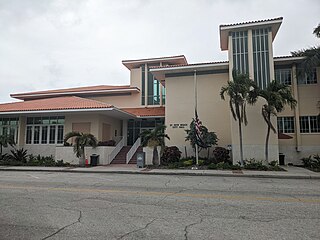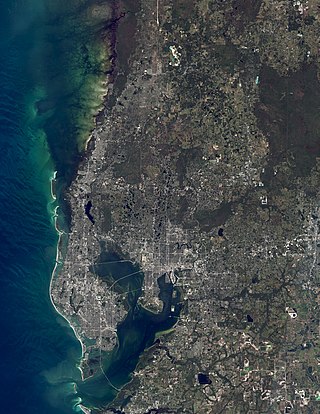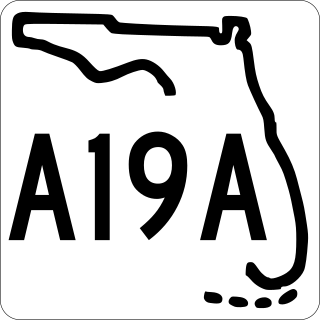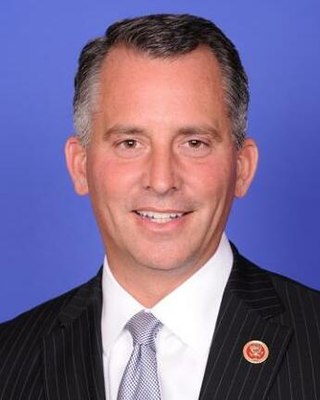
Pinellas County is a county located on the west central coast of the U.S. state of Florida. As of the 2020 census, the population was 959,107, which makes it the seventh-most populous county in the state. It is also the most densely populated county in Florida, with 3,491 residents per square mile. The county is part of the Tampa–St. Petersburg–Clearwater Metropolitan Statistical Area. Clearwater is the county seat. St. Petersburg is the largest city in the county, as well as the largest city in Florida that is not a county seat.

St. Petersburg is a city in Pinellas County, Florida, United States. As of the 2020 census, the population was 258,308, making it the fifth-most populous city in Florida and the second-largest city in the Tampa Bay Area, after Tampa. It is the largest city in the state that is not a county seat. Along with Clearwater, these cities are part of the Tampa–St. Petersburg–Clearwater Metropolitan Statistical Area, the second-largest in Florida with a population of around 2.8 million. St. Petersburg is on the Pinellas peninsula between Tampa Bay and the Gulf of Mexico, and is connected to mainland Florida to the north.

Clearwater is a city located in Pinellas County, Florida, United States, west of Tampa and north of St. Petersburg. To the west of Clearwater lies the Gulf of Mexico and to the southeast lies Tampa Bay. As of the 2020 census, the city had a population of 117,292. Clearwater is the county seat of Pinellas County and is the smallest of the three principal cities in the Tampa–St. Petersburg–Clearwater metropolitan area, most commonly referred to as the Tampa Bay Area.

St. Pete Beach is a coastal city in Pinellas County, Florida. Known as a tourist destination, St. Pete Beach was formed from the towns of Pass-a-Grille, Belle Vista, St. Petersburg Beach, and unincorporated Pinellas County. It is part of the Tampa Bay area. The population was 8,879 at the 2020 census.

St. Pete–Clearwater International Airport is a public/military airport in Pinellas County, Florida, United States, serving the Tampa Bay Area. It is right on the northeast municipal boundary of Pinellas Park, 9 miles (14 km) north of downtown St. Petersburg, 7 miles (11 km) southeast of Clearwater, and 17 miles (27 km) southwest of Tampa.

The Tampa Bay area is a major metropolitan area surrounding Tampa Bay on the Gulf Coast of Florida in the United States. It includes the main cities of Tampa, St. Petersburg, and Clearwater. It is the 17th-largest metropolitan area in the United States, with a population of 3,175,275 as of the 2020 U.S. Census.

Mediterranean Revival is an architectural style introduced in the United States, Canada, and certain other countries in the 19th century. It incorporated references from Spanish Renaissance, Spanish Colonial, Italian Renaissance, French Colonial, Beaux-Arts, Moorish architecture, and Venetian Gothic architecture.

State Road A19A was a highway loop in the southern portion of Pinellas County, Florida. The southern terminus was at an intersection with 54th Avenue South, 34th Street South and Interstate 275/SR 93 in St. Petersburg, just north of the Sunshine Skyway. The northern terminus was an intersection with US 19 in Largo.

Timeline of Pinellas County, Florida history.
The Pinellas Suncoast Transit Authority (PSTA) is a government agency that provides public transportation for Pinellas County, Florida. The authority manages a fixed-route bus system that encompasses over 40 bus routes - including two express routes to Tampa; the Central Avenue Trolley; the Suncoast Beach Trolley; and the bus rapid transit service, the SunRunner.
Pink Palace may refer to:

This is a list of the National Register of Historic Places listings in Pinellas County, Florida.

The Episcopal Diocese of Southwest Florida is a diocese of the Episcopal Church in the United States of America (ECUSA) in Florida which extends from Marco Island on the south, to Brooksville on the north, and inland to Plant City, Arcadia and LaBelle on the east. As part of the ECUSA, the diocese is a constituent member of the worldwide Anglican Communion.

John Stansel Taylor (1871-1936) was a Largo, Florida politician, citrus grower, and businessman who served as the first State Senator from Pinellas County, Florida. He was born "six miles south of Largo" on March 21, 1871, before Largo became a municipality and when Pinellas County was still Western Hillsborough County. Taylor’s parents were among the Pinellas Peninsula's first pioneers, and he was one of the first residents to be born in the Largo area. He was one of four members of his family to serve in the State Legislature. He was one of the largest landowners in Pinellas County, owning citrus groves and a packing plant at a time when Largo was nicknamed "Citrus City." Taylor was President of the Florida Citrus Exchange and a Member of the State Citrus Commission. He has been called "the father of Pinellas County." He died in 1936. Taylor Lake Park, a Pinellas County park, was named in his honor.
Thomas Rowe (1829–1899) was a British-born architect, builder and goldminer in Australia.
Nardo's Natural is a family-owned organic skincare company headquartered in Clearwater, Florida.

A special election for Florida's 13th congressional district was held March 11, 2014, to elect a member of the United States House of Representatives, following the death of incumbent Republican Congressman Bill Young on October 18, 2013. Primary elections were held on January 14, 2014. Young, who had already announced that he would not be running for re-election in 2014, was re-elected in 2012 with 57 percent of the vote. With 100% of the precincts reporting, David Jolly was declared the winner.

Henry H. Dupont was an American architect. He practiced from Indianapolis, Indiana, and then Pinellas County, Florida.

Pass-a-Grille is a small beach neighborhood and former town at the south end of St. Pete Beach in Pinellas County, Florida. The community includes the Pass-a-Grille Historic District, Gulf Beaches Historical Museum, and Pass-A-Grille Beach. The neighborhood includes restaurants, retailers, and waterfront areas on the Gulf of Mexico as well as the Intracoastal Waterway. It is located on a barrier island.

St. Petersburg, Florida, held an election for mayor on August 24, 2021. Incumbent Democratic mayor Rick Kriseman was term-limited and could not seek a third term in office. Municipal elections in St. Petersburg are officially nonpartisan. All candidates appeared on the same primary ballot, and because no candidate garnered at least 50% of the vote, the top two vote-getters advanced to a runoff election on November 2, 2021. Former Pinellas County commissioner Ken Welch easily defeated city councillor Robert Blackmon in the runoff and became the first black mayor of St. Petersburg.




















